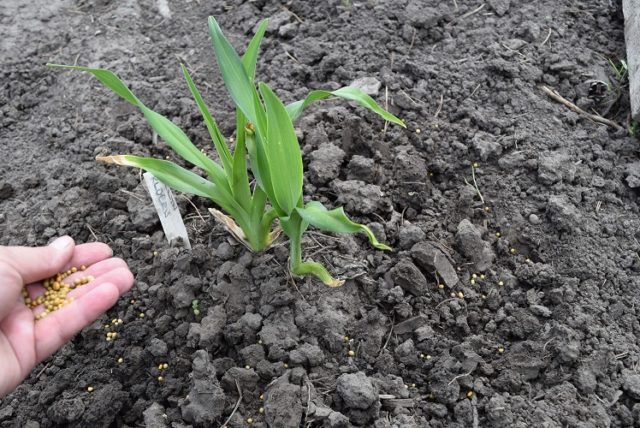Content
Daylilies are one of the most common flowers grown in every corner of the country. All thanks to their unpretentiousness and beauty, however, they also require minimal care. A special place is occupied by the preparation of daylilies in the fall for winter.
Features of preparing daylilies for winter
The preparatory process is a set of measures that allows the rhizomatous perennial to successfully withstand cold and frost. This leads it to subsequent flowering.
There are several stages of preparation:
- late autumn watering;
- fertilizing and replanting;
- pruning;
- covering or mulching.
All this is not difficult, but there are nuances that every gardener should know about.

Southern varieties need careful preparation for winter
In order for daylilies to successfully survive the winter, they must be properly prepared. To do this, you need to know what varieties grow on the site, their winter hardiness and flowering times. After all, each specific type of mulch is different. Some perennials need to be covered with non-woven material to prevent them from freezing, others need a high layer of mulch.
When to start preparing daylilies for winter
Regardless of the specifics of the variety, in each region of Russia daylilies are prepared for winter at a certain time. This way the plants tolerate cold better and bloom profusely.
Daylilies are frost-resistant perennials, so in the south of the country they do not need additional shelter or special preparation. It is enough to trim the leaves. This needs to be done before the cold weather, so that new leaf cover does not have time to grow.
In the middle zone and the Moscow region, preparation of daylilies for winter begins in mid-October and continues until November. A more precise date can be determined based on weather conditions. When the temperature drops below 0°C, it's time to get to work.
In Siberia, it is recommended to dig up daylilies, but if this is not possible, then preparations for winter begin when the average daily temperature drops below 3°C. However, it must be borne in mind that severe and prolonged frosts can destroy even the most winter-hardy varieties of perennials.
In the Urals, winter is long, so it is better to prepare daylilies in early October. Perennials need good multi-layer cover.
There is one more rule that you can follow when preparing daylilies for winter. All procedures must be completed a week before the expected frost, regardless of the variety and type of perennial.
How to prepare daylilies for winter
Autumn care and preparation of daylilies for winter at the dacha is not a difficult task, even a novice gardener can handle it. There are many tips and measures, but with experience, everyone makes their own plan of action.
Watering
In summer, daylilies need regular watering.The soil is moistened 1-2 times with an interval of seven days. In autumn, watering is usually not carried out, especially in regions with prolonged and heavy rains. The plant will have enough moisture. However, if the weather is dry, then the bushes need to be watered additionally. It is important to remember that water must saturate the entire earthen ball, since the roots of the perennial go deep.
Top dressing
Abundant flowering greatly depletes the perennial, so preparation for winter includes fertilizing. Before the cold weather, the rhizomes must receive maximum nutrition in order to withstand the upcoming frosts well.
The last feeding is usually applied in the second ten days of September. You can use both mineral fertilizers and organic matter. Preference should be given to:
- phosphorus-potassium mixtures;
- humus;
- mature compost;
- ash.
After applying all the fertilizers, the plant is watered abundantly.
It is better to apply mineral phosphorus complexes in dry form directly under the bushes. The soil is first loosened, after which the granules are scattered and mixed with the soil. Such feeding prepares the rhizomes for winter and helps the transplanted plants better adapt to their new location.

Superphosphate or phosphate rock is often used to feed daylilies.
It is also better to add organic matter in dry form, but solutions can also be used. To do this, you should make grooves around the plant, pour them well with fertilizer, and then fill them up. Organic matter in preparation for winter is necessary for daylilies, as it increases its resistance to disease.
Trimming
Daylilies of all varieties must be pruned for the winter, regardless of the region of cultivation.This preparation is done in order to avoid fungal infections of the plant. The remaining foliage gradually begins to rot, which leads to the development of pathogenic microflora. A perennial without pruning tolerates winter worse, often gets sick and may even die. In addition, pests and other microorganisms gather under the remains of foliage to overwinter.
Peduncles are cut off immediately after flowering, without waiting for them to dry out. This stimulates the appearance of new buds. In late daylily varieties, the very last flower stalks are cut off along with the foliage somewhere in early October-November.
Perennial leaves are cut off only after they have completely dried out. In living tissues, the process of photosynthesis still occurs, and all useful substances go down to the rhizome, which is very important for the plant. As a rule, in preparation for winter, daylilies are pruned shortly before frost or in its first days. All plant residues are carefully removed from the flowerbed and burned, especially if the plant is sick.
How to cover a daylily for the winter
Not all varieties of daylilies require careful preparation for winter and shelter. However, in the Leningrad region, the Urals and Siberia it is better to pay special attention to this. If the winter in the region has little snow and the temperature drops below -20°C, then additional shelter is necessary.
Those varieties that are most resistant to frost are prepared last. This can be done after the air temperature drops below 0°C. More heat-loving varieties are mulched even before the onset of frost.
You can cover daylilies for the winter with various available materials. Good to use:
- peat;
- dry leaves;
- sawdust;
- spruce branches;
- straw;
- humus.
Varieties bred in South America need to be covered with non-woven material.
All transplanted plants also need reliable shelter, since they have not yet had time to adapt to the new place. To protect the rhizomes from cold gusty winds, they are first mulched with a thick layer of humus. Height is about 10 cm. In regions with little snowy winters, they additionally install a frame shelter and stretch lutrasil or spunbond. If there is enough snow, then it is thrown onto the bushes and compacted along the edges. The procedure is repeated throughout the winter so that the snow depth is at the same level. Additionally, mulched bushes can be covered with a wooden box.
In the spring, when the temperature rises above 0°C and lasts for several days, any shelter is removed. If this is not done, the daylily may die out. This is especially dangerous for regions where there are frequent thaws in winter. All last year's mulch must be burned, as there may be pests underneath it. If all procedures were done correctly, the plant grows quickly.
Advice from experienced gardeners
Young daylilies require additional shelter for the winter, but adult plants tolerate cold weather well under snow cover. They do not need special preparation or insulation, just trimming is enough.
In the Urals and Siberia, it is better to dig up the rhizomes of valuable varieties of daylily and store them in the basement, on a glazed loggia or balcony. They are planted in a permanent place with the arrival of spring.
Preparing for winter includes trimming daylily leaves.Here you need to follow a simple rule so as not to provoke the growth of young foliage. All peduncles and stems are cut off so that small stumps remain; you cannot cut at the root. To work, use a sharp tool and trim the leaves with a fan.
Early pruning of young plants and newly transplanted plants will encourage leaf growth. This is unacceptable, since the rhizomes weaken and lose some of their nutrients before winter. Therefore, in the warm autumn you can wait a bit with preparation.
Fresh manure is not used to mulch perennials; it contains fungi that cause root collar rot.
Before covering daylilies for the winter, be sure to check the weather forecast. If warming is expected, the bushes may dry out; mulching will have to wait.
Materials for mulching are prepared in advance and dried well so that the cold does not take you by surprise.
All fertilizers are applied strictly according to the instructions so as not to damage the rhizomes. Nitrogen fertilizing is not used in the autumn, as it provokes the growth of dormant buds. If green foliage grows, the plants will go away unprepared for winter. This weakens them and makes them susceptible to diseases and pests.
Conclusion
Preparing daylilies for winter in the fall is an important procedure that should not be neglected. The climate of Russia is so unstable that the approach to perennials will be different in different regions. However, proper proper care ensures lush and long-lasting flowering and strengthens the daylily’s immunity.








